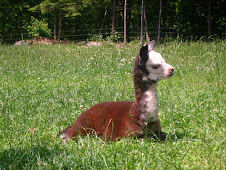Tuesday, March 16, 2010
Do the Rot Thing - Composting Your Camelid Manure 101
Human society and its agriculture depend on the health of the soil and water. Your alpaca manure can either be an asset to your farm or a contaminant to the environment. By employing simple on-farm composting techniques you can easily turn your manure into a marketable product or integrate it back into your farm in as little as 120-360 days.
Identifying a Composting Site on Your Farm
The quality of your composting site will have a significant impact on the ease of pile management and the quality of the compost produced. Considerations in choosing your site:
• What will you be composting (manure, hay, other?) and where on the farm will that material be coming from? Obviously, the shortest distance to travel with the materials is desired. If you are composting materials other than the waste from your farm it may require a permit.
• Will you compost throughout the winter or have an active summer pile and a winter stock pile?
• You will need enough space to begin a pile that is mountainous in shape with a convex top, 3-8 feet high and 6-15 feet in width at the base. The pile will be turned over the course of several weeks so that the entire pile has been turned over itself and is now in a new location.
• Will you turn your pile by shovel or bucket loader? If bucket loader, then you will need space to move about with the equipment.
• A sunny location speeds up the process.
Follow the minimum recommendations for environmental protection.
• Min. distance to bedrock: 3-6 feet
• Min to ground water: 1-1/2-3 feet
• Distance to property boundary or public roads: 100 feet unless permission is obtained.
• Distance to wells, springs, surface waters or wetlands: 25-100 feet upslope and 300 feet downslope of the pile. (A site should not be located in an area with potential for flooding.)
• Site slope: 2-3% grade is ideal, 1.5-6% tolerable
The Recipe
You are striving for approximately 60% moisture content and a ratio of 25-30 parts carbon per 1 part nitrogen (C:N - 25-30:1). This will create the habitat and diet for your decomposer populations (earthworms, microorganisms, etc). While it is important to understand how the recipe is arrived at, I don’t recommend going through a six-page worksheet of calculations to create compost on your farm. Below is a simplified version of how the recipe is arrived at followed by a very simplified estimate of what you want your hay/bedding to manure ratio to be.
1. Carbon to Nitrogen Ratio - Bedding to Manure Ratio
• Manure – what is the carbon/nitrogen makeup of your manure? You can have it tested or you can approximate C:N – 16:1.
• Bedding – this is usually a carbon component (paper, hay, straw, cardboard). Again, you can have it tested or estimate it to be C:N – 45:1.
• Ratio of bedding to manure – From the above you can see that your manure already has a high level of carbon as does the bedding. Now you just need to get the right mixture. After factoring in moisture content to the above two figures the calculations would bring you to a ratio of about .32 pounds of bedding to 1 pound of manure (or Bedding:Manure – 32:100) Simplified even further this comes out to be roughly 1 part bedding to just over 3 parts manure. In the summer months this means you will need to add (1 part) bedding to (3 parts) manure if scooped directly from pasture piles. Although it would seem that your winter pile would have too much bedding and not enough manure, remember that you are adding moisture/urine. The winter mix will likely be correct but after monitoring it can be amended.
2. Moisture Content – this is critical to the pile health and a good method of determining if you are getting your C:N ratio correct. To monitor, dig 12” deep into the pile and grab a handful of material and squeeze. If it is:
• Dripping = too moist (about 65%+ moisture content, want 60%)
• Damp and glistening = Ideal 60%
• Crumbling = too dry (below 60%)
• Sniff – if it has a gassy smell it is too moist or too much Nitrogen (manure)
Turning
You should plan on turning the pile about once a week. Turn pile ¼ at a time by taking material from the side and dumping it on top. Your pile should, again, be a mountainous shape with a convex top after you have turned it. Continue turning ¼ at a time until the pile resembles loose crumbly dark soil. It should take about 3 months in the spring/summer months. An alternative to turning it yourself would be to pasture pigs with your pile. They’ll be in hog heaven and you will too as they do the turning for you!
Pile Monitoring
Ideally you would do this every time you walk by the pile; at a minimum once a week.
1. Temperature – you want it to reach 130 degrees w/in a few days to a week. It will need to stay at this temp. for several days to kill pathogens and seeds. You can monitor with a 3’ probe thermometer or dig in and if too hot to touch you’re over 120 degrees. If it is excessively hot you are killing your decomposers.
2. Moisture – Look at the pile and reach in and take a handful and squeeze. Is it dripping, glistening, crumbly? Add more bedding if too wet or manure if too dry. Open top to allow rain in if too dry.
3. Odor – smell the pile as you work it and inspect for moisture. It should smell earthy. If it doesn’t it means it is either too low in carbon (bedding) or low in oxygen (too moist or too dense).
4. Visual Inspection – Dry? Damp? Crusting on the surface (reduces available air in pile)?
The Finished Product
Curing – After composting is finished, allow your pile to cure for 1-3 months. Make sure it is covered.
Testing – you can test your finished product so that you know how you did or what you are spreading on your pastures or to aid in commanding an excellent price for it.
Ideas for Selling
Bag it in used feed bags and sell to local gardeners or place an ad on Craig’s List for someone to buy and take away the whole pile. Top dress your pastures in the fall and you will have lush pastures in the spring. Just price a bag of “Moo Doo” (composted cow manure) and you’ll know how valuable your composted manure is!
Simplified into 5 Easy Steps
1. Recipe - Pile your manure and bedding in a mountainous heap with a convex top in a ratio of 1 part bedding to a little more than 3 parts manure.
2. Turn – Turn your pile over itself ¼ at a time once a week for 3+ months til done.
3. Monitor your pile – feel, look, smell to see if you have the right mix.
4. Cure – after you have made “dirt”, cover it and let it cure for 1-3 months depending on the time of year.
5. Harvest – Use or sell this valuable resource generated by your farm’s waste! And feel good that you “Did the Rot Thing” for the environment by composting!
Identifying a Composting Site on Your Farm
The quality of your composting site will have a significant impact on the ease of pile management and the quality of the compost produced. Considerations in choosing your site:
• What will you be composting (manure, hay, other?) and where on the farm will that material be coming from? Obviously, the shortest distance to travel with the materials is desired. If you are composting materials other than the waste from your farm it may require a permit.
• Will you compost throughout the winter or have an active summer pile and a winter stock pile?
• You will need enough space to begin a pile that is mountainous in shape with a convex top, 3-8 feet high and 6-15 feet in width at the base. The pile will be turned over the course of several weeks so that the entire pile has been turned over itself and is now in a new location.
• Will you turn your pile by shovel or bucket loader? If bucket loader, then you will need space to move about with the equipment.
• A sunny location speeds up the process.
Follow the minimum recommendations for environmental protection.
• Min. distance to bedrock: 3-6 feet
• Min to ground water: 1-1/2-3 feet
• Distance to property boundary or public roads: 100 feet unless permission is obtained.
• Distance to wells, springs, surface waters or wetlands: 25-100 feet upslope and 300 feet downslope of the pile. (A site should not be located in an area with potential for flooding.)
• Site slope: 2-3% grade is ideal, 1.5-6% tolerable
The Recipe
You are striving for approximately 60% moisture content and a ratio of 25-30 parts carbon per 1 part nitrogen (C:N - 25-30:1). This will create the habitat and diet for your decomposer populations (earthworms, microorganisms, etc). While it is important to understand how the recipe is arrived at, I don’t recommend going through a six-page worksheet of calculations to create compost on your farm. Below is a simplified version of how the recipe is arrived at followed by a very simplified estimate of what you want your hay/bedding to manure ratio to be.
1. Carbon to Nitrogen Ratio - Bedding to Manure Ratio
• Manure – what is the carbon/nitrogen makeup of your manure? You can have it tested or you can approximate C:N – 16:1.
• Bedding – this is usually a carbon component (paper, hay, straw, cardboard). Again, you can have it tested or estimate it to be C:N – 45:1.
• Ratio of bedding to manure – From the above you can see that your manure already has a high level of carbon as does the bedding. Now you just need to get the right mixture. After factoring in moisture content to the above two figures the calculations would bring you to a ratio of about .32 pounds of bedding to 1 pound of manure (or Bedding:Manure – 32:100) Simplified even further this comes out to be roughly 1 part bedding to just over 3 parts manure. In the summer months this means you will need to add (1 part) bedding to (3 parts) manure if scooped directly from pasture piles. Although it would seem that your winter pile would have too much bedding and not enough manure, remember that you are adding moisture/urine. The winter mix will likely be correct but after monitoring it can be amended.
2. Moisture Content – this is critical to the pile health and a good method of determining if you are getting your C:N ratio correct. To monitor, dig 12” deep into the pile and grab a handful of material and squeeze. If it is:
• Dripping = too moist (about 65%+ moisture content, want 60%)
• Damp and glistening = Ideal 60%
• Crumbling = too dry (below 60%)
• Sniff – if it has a gassy smell it is too moist or too much Nitrogen (manure)
Turning
You should plan on turning the pile about once a week. Turn pile ¼ at a time by taking material from the side and dumping it on top. Your pile should, again, be a mountainous shape with a convex top after you have turned it. Continue turning ¼ at a time until the pile resembles loose crumbly dark soil. It should take about 3 months in the spring/summer months. An alternative to turning it yourself would be to pasture pigs with your pile. They’ll be in hog heaven and you will too as they do the turning for you!
Pile Monitoring
Ideally you would do this every time you walk by the pile; at a minimum once a week.
1. Temperature – you want it to reach 130 degrees w/in a few days to a week. It will need to stay at this temp. for several days to kill pathogens and seeds. You can monitor with a 3’ probe thermometer or dig in and if too hot to touch you’re over 120 degrees. If it is excessively hot you are killing your decomposers.
2. Moisture – Look at the pile and reach in and take a handful and squeeze. Is it dripping, glistening, crumbly? Add more bedding if too wet or manure if too dry. Open top to allow rain in if too dry.
3. Odor – smell the pile as you work it and inspect for moisture. It should smell earthy. If it doesn’t it means it is either too low in carbon (bedding) or low in oxygen (too moist or too dense).
4. Visual Inspection – Dry? Damp? Crusting on the surface (reduces available air in pile)?
The Finished Product
Curing – After composting is finished, allow your pile to cure for 1-3 months. Make sure it is covered.
Testing – you can test your finished product so that you know how you did or what you are spreading on your pastures or to aid in commanding an excellent price for it.
Ideas for Selling
Bag it in used feed bags and sell to local gardeners or place an ad on Craig’s List for someone to buy and take away the whole pile. Top dress your pastures in the fall and you will have lush pastures in the spring. Just price a bag of “Moo Doo” (composted cow manure) and you’ll know how valuable your composted manure is!
Simplified into 5 Easy Steps
1. Recipe - Pile your manure and bedding in a mountainous heap with a convex top in a ratio of 1 part bedding to a little more than 3 parts manure.
2. Turn – Turn your pile over itself ¼ at a time once a week for 3+ months til done.
3. Monitor your pile – feel, look, smell to see if you have the right mix.
4. Cure – after you have made “dirt”, cover it and let it cure for 1-3 months depending on the time of year.
5. Harvest – Use or sell this valuable resource generated by your farm’s waste! And feel good that you “Did the Rot Thing” for the environment by composting!
Subscribe to:
Post Comments (Atom)









No comments:
Post a Comment